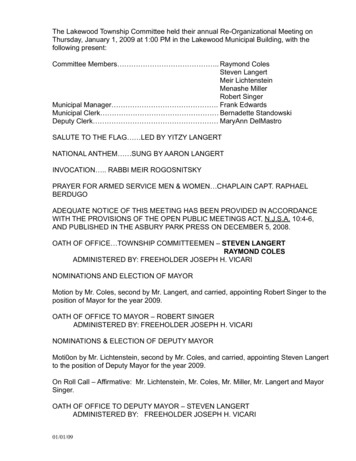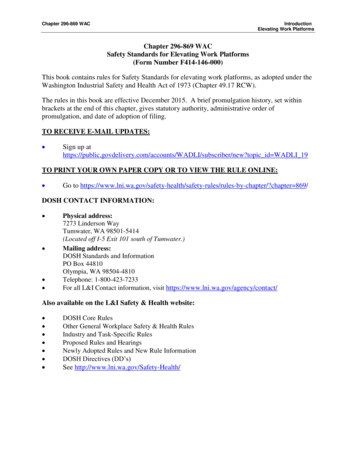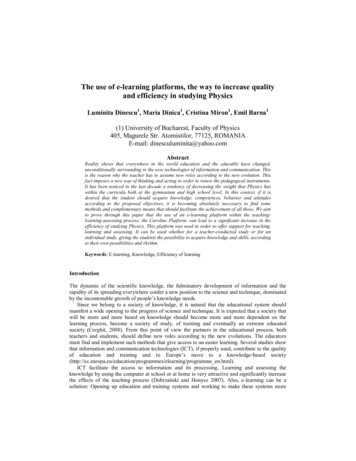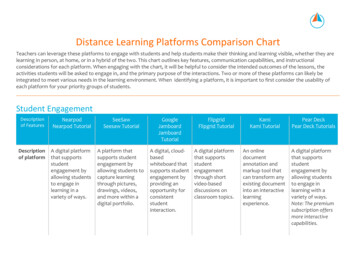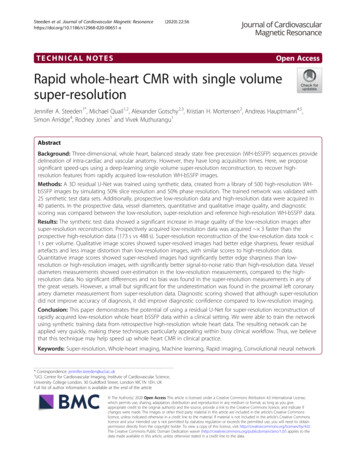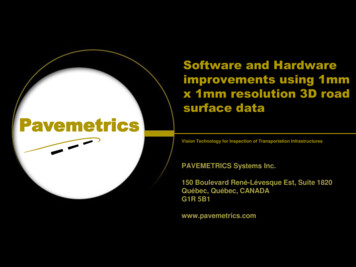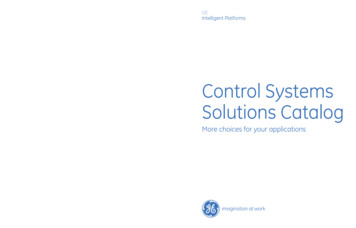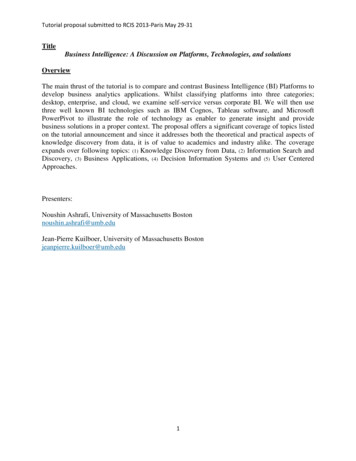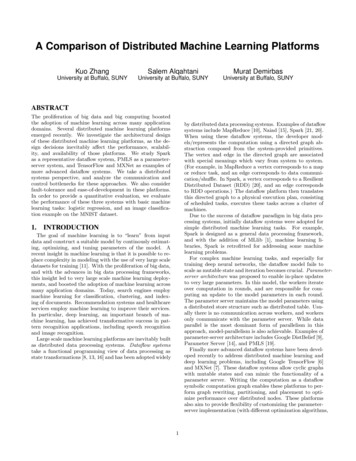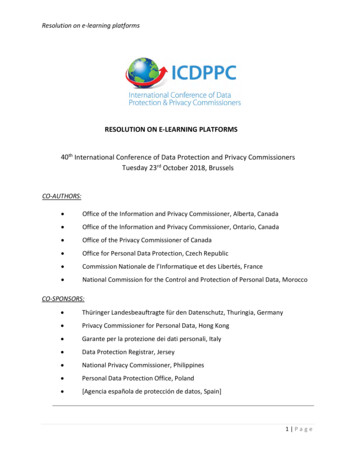
Transcription
Resolution on e-learning platformsRESOLUTION ON E-LEARNING PLATFORMS40th International Conference of Data Protection and Privacy CommissionersTuesday 23rd October 2018, BrusselsCO-AUTHORS: Office of the Information and Privacy Commissioner, Alberta, Canada Office of the Information and Privacy Commissioner, Ontario, Canada Office of the Privacy Commissioner of Canada Office for Personal Data Protection, Czech Republic Commission Nationale de l’Informatique et des Libertés, France National Commission for the Control and Protection of Personal Data, MoroccoCO-SPONSORS: Thüringer Landesbeauftragte für den Datenschutz, Thuringia, Germany Privacy Commissioner for Personal Data, Hong Kong Garante per la protezione dei dati personali, Italy Data Protection Registrar, Jersey National Privacy Commissioner, Philippines Personal Data Protection Office, Poland [Agencia española de protección de datos, Spain]1 Page
A global marketplace of e-learning platforms has emerged to help education authorities provideenhanced educational services and improve outcomes for children and youth. A growing numberof educational authorities are using these platforms to support the delivery of education in theclassroom, and to gain a better understanding of student learning needs.Some of these e-learning platforms and the learning analytics they facilitate have enormouscapacity to foster the development of innovative and effective learning practices. At their best,they can enhance and complement the interactions of students, parents and educators in theeducational environment and help them fulfil their respective potential. Nevertheless, e-learningplatforms may pose threats to privacy arising from the collection, use, reuse, disclosure andstorage of the personal data of these individuals.The personal data of children and youth merit specific protection and should be processed onlyon the basis of sufficient legal ground. Children and youth are entitled to have their privacyprotected and must be able to exercise their data protection rights with the support of theirparents or guardians. Parents have to be able to assist their children and participate actively inthe exercise of these rights.Classrooms have become increasingly networked environments that may put the privacy ofchildren at risk. Specifically, these connected classrooms raise issues of transparency, in view ofthe fact that inappropriate data processing practices by e-learning platforms, opaque automateddecision-making and misuse of learning analytics risk undermining data protection and privacyrights. In the case of children and youth, this can have significant and long-term social, economicand professional consequences, and fail to account for their evolving capacities.Based on the above, and in keeping with the objective of adopting resolutions on subjects ofcommon interest or concern, the 40th International Conference of Data Protection and PrivacyCommissioners (ICDPPC) calls upon all relevant parties in the field of e-learning, and particularly E-learning platform providers and manufacturers, including providers of data drivenservices directed at students; and2 Page
Educational authorities, including ministries of education, school boards, schooladministrators and educatorsto fully respect students’, parents’ and educators’ (“individuals”) rights to the protection of theirpersonal data and privacy, and to guarantee that the data collected is solely used for educationalpurposes in compliance with data protection law.Parties are urged to take the recommended actions below at every stage of the development,implementation and use of e-learning platforms.1) Educational authorities are called upon to:a) Ensure they have authority and expertise to engage the services of e-learning platforms.There should be a clear internal allocation of roles, responsibilities and delineation ofauthority between educators, school administrators and other relevant educationalauthorities to be able to establish legal authority and accountability when dealing andcontracting with providers of e-learning platforms. The authorized representatives shouldhave a clear understanding of applicable data protection and privacy laws to guaranteeits inclusion in the terms and provisions of the contracts and third party agreements.b) Develop policies and procedures to evaluate, approve and support the use of e-learningplatforms and, where feasible or required, conduct data protection/privacy impactassessments. These policies should promote individual control over personal data, clarifythe roles and responsibilities among the various actors involved in e-learning platforms,mitigate risks and promote accountability.c) Provide training and on-going support for educators. Educators must be equipped withup-to-date, relevant and sufficient information on data protection and privacy rights tobe able to implement effective e-learning platforms. Access to resources, trainings andworkshops enable educators to maximize the benefits of e-learning platforms and to thenprovide effective guidance and support to students and parents on proper use.3 Page
d) Work with other educational authorities and, in cooperation with local data protectionauthorities, to agree on common standards for engaging e-learning platforms. Thiscollaborative approach towards commonly accepted practices increases leverage,knowledge exchange, best practice development, and resource maximisation in order toovercome any inconsistent privacy and security practice in the delivery of e-learningplatform services.e) Where required or appropriate, seek valid, informed and meaningful consent fromindividuals. The legal basis for the processing of student data by an e-learning platformcommissioned by an educational institution should be determined by law or rulesestablished by competent regulatory authorities, wherever available. If no such legal basisis available, parental consent, student consent or both, as appropriate, must be obtained.The validity of this consent presumes that its withholding leads to no disadvantage of thestudent compared to their consenting peers. The decision, at any time, to opt out orwithdraw consent should allow individuals to opt out of all or some of the data processing,if practical.f) Consistent with domestic law, implement a policy for individuals who access the elearning platform with their personal electronic devices. This policy should clarifyappropriate uses of the e-learning platform and any consequences of using a personaldevice – especially when installing software or mobile applications.2) Educational authorities and e-learning platform providers and manufacturers are calledupon to, jointly or independently according to domestic data protection law:a) Ensure that e-learning platforms appropriately safeguard users’ personal data and meetthe appropriate data protection standards. However the use of e-learning platforms isgoverned, the provisions must always be consistent with applicable data protection lawsand requirements.b) Make sure that the purposes for which personal data are being collected, processed andused are legitimate, suited to the context and authorized by law. All collection of student4 Page
data should be limited to what is needed for educational purposes. By default, no otheruse of this data should take place, including for commercial or marketing purposes.Student data must never be repurposed or used for non-educational purposes withoutfreely given express consent, unless there is legislation allowing for re-purposing.Secondary processing should proceed with de-identified data whenever possible,including for statistical and research purposes.c) Minimise the amount of personal data to be processed. The collection, use, retentionand disclosure of personal data, and particularly student data, should always be limitedto what is necessary to fulfil authorized purposes. Reducing the risk posed by theexcessive collection of student data should be a core principle to guide data processingpractices of e-learning platforms.d) Before collecting personal data, notify individuals about the personal data to beprocessed by the e-learning platform and the reasons for processing. The notice shouldbe provided in a timely, age-appropriate, clear and concise fashion. Graphics, audio, videoor other media may be used in addition to textual information. More detailed informationshould be easily accessible. The notice needs to enable individuals to make informeddecisions. Further, notices should explain uses and disclosures to third parties, the risksof harm arising from processing personal data, a summary of protections and assurancesin place, and an account of existing privacy rights and options available.e) As far as possible, allow individuals to use the e-learning platform with de-identifieddata. To avoid the excessive collection of personal data, individuals should be able to usethe e-learning platforms anonymously or with unlinkable pseudonyms.f) As far as possible, avoid the use of personal data per se, and particularly data onlearning behaviour, for predictive purposes, profiling or automated decision-making.The use of students’ personal data to make subjective assessments or generateassumptions has the potential to undermine the evolving capacities of children and youth.Where the data is used for statistical analysis and profiling, for making subjectiveassessments, for predicting behaviour or as part of a decision-making process it should5 Page
be clearly communicated to students and parents. They should be provided withmechanisms to challenge these assessments.g) Embed and employ tools that enable individuals to control their personal data andeffectively exercise their privacy rights, including their right to access, correction,erasure and, where applicable, data portability. These rights over personal data shouldbe extended to any metadata, inferences, assessments, and profiles compiled aboutstudents, parents and educators.h) Set and respect retention periods for different categories of personal data. Retain dataand metadata only as long as required to satisfy the purposes of collection and theirintended use. In particular, logs of interactions between students, parents and educatorsshould be purged regularly. Upon expiration of the retention period, proper method ofdisposal or destruction shall be instituted to ensure secure disposal of personal data.3) E-Learning platform providers and manufacturers are called upon to:a) Be transparent about their data processing practices to both educational authoritiesand the individuals using the e-learning platforms. Individuals should be provided asingle point of contact to address privacy and data protection concerns related to each elearning platform. They have a right to question a company’s data management practicesand to complain to a data protection authority if they are unsatisfied with the company’sexplanation or are concerned that personal data has been mishandled.b) Limit the purposes for collecting personal data as appropriate to context, and specify intheir terms of services or other legal contracts when personal data may be disclosed.Student data must never be repurposed or used for non-educational purposes withoutexpress consent, unless there is legislation allowing for the repurposing.c) Be clear, specific and consistent in their terms and conditions of services. Companiesshould avoid using terms such as “educational purposes” that are overly broad and donot inform individuals in sufficient detail to understand how personal data is being used.6 Page
d) Adopt Privacy Enhancing Technologies and apply the principles of Privacy by Design andby Default. Practices and technologies that minimize or eliminate the collection and useof personal data should always be preferred, and their effectiveness should be routinelymonitored and improved upon.e) Ensure that personal data is stored in compliance with local data protection legislation.Administrative, physical and technical safeguards should be in place to ensure the lawfulprocessing of all personal data in compliance with applicable requirements and avoid therisk of inadequate security.4) Lastly, Members of the ICDPPC are called upon to:a) Inform and raise awareness of the privacy risks and responsibilities of using e-learningplatforms;b) Use this Resolution to develop guidelines that assist educational authorities and elearning platform providers and manufacturers in meeting their data protection andprivacy obligations;c) Promote this Resolution and its recommendations with stakeholders and policy-makersin their jurisdictions and networks;d) Liaise with relevant international organizations and civil society groups to promote andfollow up on the Resolution; ande) Cooperate with each other and with the Digital Education Working Group to shareresources, knowledge and best practices.7 Page
ANNEX TO THE RESOLUTION ON E-LEARNING PLATFORMSThis Annex contains TWO PARTS:Part A.Complementary and Explanatory Notes; and,Part B.Suggestions to Assist Members with the Implementation of this ResolutionPart A.Complementary and Explanatory NotesThe Resolution on E-Learning Platforms (the Resolution) builds upon previous work conductedby ICDPPC working groups and related networks, most notably the International Working Groupon Data Protection in Telecommunication’s Working Paper on E-Learning Platforms 1; the GlobalPrivacy Enforcement Network’s 2017 GPEN Sweep Report on Online Educational Services2; andthe Digital Education Working Group’s Report on the Results of a survey on Educational LearningPlatforms. 3 Taken together, there is a recognized desire for a resolution on e-learning platforms.The Resolution addresses key privacy and security considerations relating to computer software,mobile applications, and web-based tools specifically provided to schools that students, parentsand educators access via the Internet and use as part of an educational activity.The recommendations are targeted mainly at educational authorities in their role as datacontrollers. These authorities can develop and enforce contracts and best practices for e-learningplatform providers and manufacturers to ensure uses in accordance with the data protectionlaws and individual privacy rights. A number of recommendations are also directed at e-learningplatform providers and manufacturers in their role as data processors, as they are in a positionto develop their services in a data protection and privacy-sensitive way.123“Berlin Working Group Paper”, n/working-paper/2017/2017IWGDPT Working Paper E-Learning Platforms-en.pdf.“GPEN Sweep Report”, pen-sweep-rpt.pdf.“DEWG Report on Survey” -Research-Paper-Canadaeplatforms Sept-2017.pdf.1 Page
DefinitionsFor the purposes of the Resolution:E-learning platforms refer to the online technological tools and media that assist in thecommunication of knowledge, its development and the interaction among educators, studentsand educational institutions. E-learning platforms typically involve a variety of devices (such ascomputers, tablets and mobile devices), data processing and usage models (in classroom, onlinecourses) and actors (students, educators, educational institutions, platform providers,application providers).The term excludes pure school management tasks operated on back office applicationsimplemented by education authorities such as transfer and assignment of educators oradministrative management of students at school that are not related to learning.Personal data refers to the personal data of students, parents and educators. It includesidentifiable information about them. This includes such information as a name, an identificationnumber, location data, biographical, health and contact details, behaviour patterns, disciplinaryrecords, special needs, and other information. It also refers to online identifiers or to one or morefactors specific to the physical, physiological, genetic, mental, economic, cultural or socialidentity of that individual.Educational authorities refer to those entities that establish curricula and set rules orframeworks on education. Educational authorities include ministries of education, their localrepresentatives, school boards, schools, management staff, and educators.Learning analytics refer to the measurement, collection, analysis and reporting of data aboutstudents and their learning practices, for the purposes of understanding and optimising learning2 Page
and the environment in which it occurs. Learning analytics includes “adaptive learning” practices,that is, the use of personal data to provide individualized teaching and support.RecommendationsThe following is offered to provide further context, explanation and examples related to theResolution’s recommendations:1) Educational authorities are called upon to:a) Ensure they have authority and expertise to engage the services of e-learning platforms. Lack of legal authority and accountability introduces unnecessary data protection risks, andcould result in privacy and security breaches, investigations and fines. Educational authoritiesmay not have authority to collect, use or disclose some types of personal data, or to permitcertain data processing operations by e-learning platforms. Educational staff, for their part,may lack authority to agree to third-party contractual terms on behalf of their school andstudents. Educational authorities should: Take steps to confirm the applicable data protection and privacy laws and internal policyrequirements that impact their authority to use e-learning platforms. Ensure that responsibility for decisions to engage e-learning platforms are clearlyassigned or delegated. Consider whether there are any limitations on their authority to use an e-learningplatform.3 Page
Ensure that the agreement with the provider of e-learning platforms stipulates that theprovider may only process student data in accordance with the instructions of theeducational institution. 4 Use a written contract or legal agreement when possible, and take extra steps whenaccepting click-wrap licenses. 5 This includes, notably:o Ensuring the offer complies with local data protection laws and requirements;o Reviewing the Terms of Service to determine if the provider has retained the rightto amend them without notice; ando Limiting authority on who can accept the Terms of Services or changes to it. 6 Where “click wrap” agreements do not meet data protection laws and internal policyrequirements, educational authorities should not use those services.b) Develop policies and procedures to evaluate, approve and support the use of e-learningplatforms and, where feasible or required, conduct data protection/privacy impactassessments. To ensure compliance with applicable laws and internal policies, educational authorities needto take steps to understand how the e-learning platform processes personal data and identifythe data protection and privacy risks that might arise, and the strategies to mitigate them.Lack of organizational readiness or understanding of the processing of personal data by elearning platforms may lead to unexpected or unintended privacy and security risks such asbreaches and inappropriate processing.456Berlin Working Group Paper, p. 6.Click-wrap licenses or agreements are those in which a user must agree to terms and conditions prior to using theproduct or service.For further information on this, see Privacy Technical Assistance Center, Protecting Student Privacy While UsingOnline Educational Services: Requirements and Best Practices, (“EdTech Paper”) pp 8-10: ry-2014.pdf4 Page
Educational authorities should: Develop methods to evaluate and mitigate privacy and compliance risks prior toimplementing e-learning platforms. Establish policies, procedures and operational standards for engaging e-learningplatforms. Promote and enforce compliance with school policies by students, parents, educators,and e-learning platform providers. Facilitate individual control over personal data by enacting technical and organisationalmeasures that support access, correction and other privacy rights in compliance with dataprotection law and policy. Continuously monitor and improve technological and organizational measures for datasecurity. Conduct an inventory of the online educational services currently being used within yourschool or district to help assess the scope and range of student, parent and educator’sdata being shared with providers. 7EXAMPLE: Useful questions to pose when considering e-learning platformsinclude, but are not limited to: 8-Will any information about students, parents or educators be sharedwith parties outside the educational authority?-Will you be sharing this information with companies or individuals thatare not school employees? If so, who will have access?78-What types of information are being shared?-Are there secondary purposes for the data that is being collected?EdTech Paper, p. 8. See also The Common Sense Privacy Evaluation Initiative for suggestions and example onconducting evaluation of e-learning platforms: man Klein Center for Internet & Society at Harvard University, Educational Technology and Student PrivacyChecklist: https:/dlrp.berkman.harvard.edu/node/59.5 Page
-Will you obtain student or parental consent to share this information?-What risks do you think sharing this information might pose to students?To you as an educator? To the school?c) Provide training and on-going support for educators. If educators are not trained on the privacy implications of using e-learning platforms, thenthey may lack competence to select, deploy, configure and use e-learning platforms in aprivacy-compliant way. For example, educators may not be well-equipped to guide studentsand parents on the appropriate use of these services. Educational authorities should: Provide educators with a list of evaluated and approved e-learning platforms. Provide educators with on-going information sessions about how the e-learning platformprocesses personal data and how to use it appropriately. This information should beadapted for use by parents and students. Put in place equitable access to up-to-date equipment and resources, as well asappropriate, job-embedded, ongoing professional development to enable educators tolearn about and experiment with new technologies. 9 Raise awareness of data protection among students by inviting educators to incorporatethe International Competency Framework for School Students on Data Protection andPrivacy 10 into their teaching methods according to the age groups concerned.This mayinclude, but is not limited to advice on how to:o Create an online account, user profile and online content;o Configure account settings and preferences;910Media Smarts, Connected to Learn: Teachers’ Experiences with Networked Technologies in the Classroom. p. ublication-report/full/ycwwiii connected to learn.pdf38th ICDPPC, on-data-protection-and-privacy.pdf6 Page
o Manage cookies, especially “third-party” tracking cookies;o Download and install software, especially on personal computing devices; ando Delete online content and/or accounts 11d) Work with other educational authorities and, in cooperation with local data protectionauthorities, to agree on common standards for engaging e-learning platforms. Failure to develop and apply common standards may result in the inconsistent application ofindividual privacy rights and obligations. Educational authorities should: Facilitate cooperation and sharing of knowledge, best practices and other resources,including the use of pre-evaluated and approved e-learning platforms. Develop and promote the use of model contract clauses, evaluation standards,certification marks, and Codes of Conduct.e) Where required or appropriate, seek valid, informed and meaningful consent fromindividuals. Individuals must be able to exercise the data protection rights in relation to the processing oftheir personal data. This includes providing or withholding consent. When the use of the elearning platform is compulsory, and without alternative options and opt-out mechanisms,the consent that is obtained is not valid, and may not be used as a legal basis for processing. Some circumstances may require express consent, such as when processing personal datathat is sensitive in nature, for new, unexpected or inconsistent purposes, or when there is arisk of significant harm.11GPEN Sweep Report, p. 8: pen-sweep-rpt.pdf.7 Page
In the educational context where e-learning platforms are employed, there is an imbalancebetween students on the one hand and educational authorities on the other. The users of ane-learning platform may not feel free to abstain from the use of an e-learning platform whengiven the choice, since this may put them at a disadvantage compared to their peers. Underthese circumstances, consent cannot be validly obtained. Certain data processing purposes may be prohibited. For example, some personal datacollections, uses, or disclosures may have a discriminatory or harmful impact on individualsand would be inappropriate. Even where educational authorities have sufficient authority to engage and use e-learningplatforms, individuals should have the right to opt out and receive educational servicesthrough alternative methods. Educational authorities should: Be prepared to accommodate opt out choices. Provide alternative means of instruction that do not require use of an e-learning platform. Where individual consent is the legal basis for data processing, educational authorities ande-learning platform providers and manufacturers should: Ensure consent is provided directly by the individual in a way that is informed and specific. Whenever necessary, obtain parental consent. When the targeted individuals includeyouth who are able to provide consent themselves, their maturity should be taken intoaccount along with context. Require express consent prior to disclosing personal information about students to apublicly-accessible site, where such practice is permitted.f) Consistent with domestic law, implement a policy for individuals who access the elearning platform with their personal electronic devices.8 Page
Many educational authorities provide computers, tablets or other computing devices and thenetworked infrastructure for use by students, parents and educators. In other cases,students, parents and educators may use their own devices to connect with the school’snetworked infrastructure. There are additional data protection and privacy risks that arisewhen using a personal device. Educational authorities should mitigate those risks by: Ensuring that their networked infrastructure is governed by clear and transparent usagepolicies. Minimizing, and where appropriate prohibiting, the collection of individuals’ personaldata, from personal devices and personal data stored on the device that is unrelated tothe educational service.2) Educational authorities and e-learning platform providers and manufacturers are calledupon to, jointly or independently according to domestic data protection law:a) Make sure that e-learning platforms appropriately safeguard users’ personal data andmeet the appropriate data protection standards. Inadequate safeguarding of users’ personal data creates unnecessary privacy and securityrisks, such as unauthorized use and disclosure of personal data. For example, sensitivestudent data could be exposed by the use of insecure login mechanisms, poor configurationof the platform, or human error, and require that additional security measures be in place. Legal agreements can ensure lawful processing by promoting effective control,accountability, and compliance. Contract provisions should support individual privacy rightsand data protection obligations. Educational authorities and e-learning platform providers and manufacturers should:9 Page
Ensure personal data protection requirements are part of any legal agreements regardinge-learning platforms, including “click-wrap” and negotiable terms of service agreements. Ensure legal agreements define types of personal data to be processed, the purposes forcollection, uses and disclosures, the location of storage and processing, retentionrequirements, and access and correction rights. They should also set out theadministrative, physical and technical safeguards and breach notification requirements. Allow for, and require, the use of a multi-factor authentication mechanism foradministrators and educators to log in to the platform to prevent misuse through stolenpasswords. Require access controls and logging policies to be in place and enforced to ensure thataccess to personal data is properly managed and supervised. Access to personal datashould follow the ‘need-to-know’ principle. Encrypt data transmissions between servers and users of online learning platforms.Depending on the respective online learning platform, the use of the encryptiontechnology has to be examined individually for this purpose.12 Continuously monitor and improve the security controls. In the event of a breach, providers of e-learning platforms and educational authorities shouldnotify educational institutions, students or their parents, and appropriate supervisoryauthorities in accordance with local data breach notification requirements.b) Make sure that the purposes for which personal data are bei
2) Educational authorities and e-learning platform providers and manufacturers are called upon to, jointly or independently according to domestic data protection law: a) Ensure that e -learning platforms appropriately safeguard users' personal data and meet the appropriate data protection standards. However the use of e-learning platforms is
